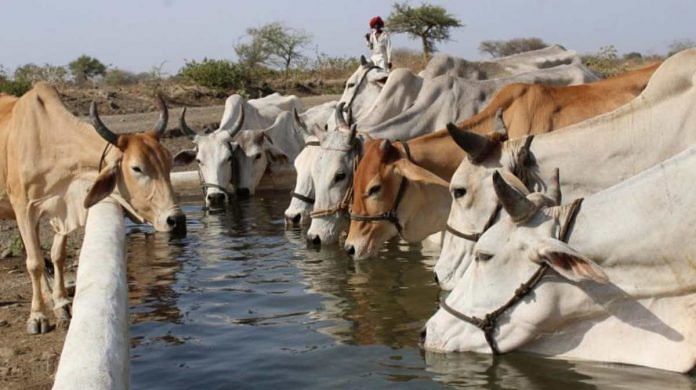New Delhi: The animal husbandry department has accused the finance ministry of being “insensitive” and “non-cooperative”, which, it said, is affecting the government’s ambitious Rashtriya Gokul Mission, aimed at promoting indigenous cattle.
The Standing Committee on Agriculture, while submitting its report before Parliament last week, stated that against a proposed allocation of Rs 2,243.87 crore for 2021-22, the department was allocated a mere Rs 502.00 crore by the Ministry of Finance for Rashtriya Gokul Mission.
Prime Minister Narendra Modi had launched the mission in 2014 to promote indigenous bovines, which is one of the major thrust areas of the BJP-led NDA government and its ideological parent RSS to enhance farmers’ income.
The report noted that the share of the Department of Animal Husbandry and Dairying in the Central Plan Outlay has stagnated at 0.12 per cent from 2018-19 to 2020-21 as compared to the share of the Department of Agriculture and Cooperation — which has grown from 1.91 per cent to 4.68 per cent from 2018-19 to 2019-20, and stayed at 4.42 per cent in 2020-21.
The committee also noted with “discontent” that the overall allocations made to the department were revised downwards to Rs 3,180.27 crore in 2019-20 and Rs 3,007.89 crore in 2020-21.
“Our contribution to GDP is 4 per cent, but we are getting just 0.09 per cent funds from the finance ministry,” it said.
Also read: This is how Modi govt is looking to breed more and more productive, disease-free cows
Cow mission ‘distant dream’
The standing committee noted that most of the physical targets set under the gokul mission for 2021-22 have either remained the same or have increased only marginally compared to 2020-21.
For instance, from 2016-17 to 2020-21, the department so far could establish only 10 Gokul Grams in the country. Gokul Grams were envisaged under the mission to develop indigenous breeds, including up to 40 per cent non-descript breeds, and to also promote indigenous cattle rearing and conservation in a scientific manner.
The panel said even the number of sex-sorted semen production facilities in the country are just two, while there is only one National Kamdhenu Breeding Centre and two National Bovine Genomic Centres for Indigenous Breeds.
The panel expressed concern over such poor performance of the department with respect to the achievement of physical targets under the mission from 2016-17 to 2020-21.
It further noted that despite the focus of the mission being conservation and improvement of indigenous cattle breed and augmenting their production and productivity, the total number of High Genetic Merit Bulls in the country, as of date, stands at a mere 3,675.
The panel also said that if performance under physical targets continues to be dismal, the aim of improving the breed of indigenous cattle in the country will only remain a “distant dream”.
‘Only focus on dogs, cats’
The report also asked, “How livestock contribution, which is one of the main contributors in doubling farmers’ income, will grow?
“For human healthcare, the budget outlay is of Rs 65,000 crore, but for animal healthcare, the budget outlay is only Rs 1,000 crore. The role of the private sector and investment in human healthcare is more elaborate, but in the case of animals, the focus is only on dogs and cats,” it said.
“Agriculture budget outlay is Rs 1.30 lakh crore, but the budget of animal husbandry is only Rs 3,000 crore (in 2020-21). Although in milk production, we are the largest producers of milk, in poultry we are third largest in the world and in meat, we are fifth largest producers,” it added.
“… There is Pradhan Mantri Kisan Samman Nidhi for farmers but there is no such scheme for livestock farmers. There is no input subsidy and no subsidy on electricity. There should be equal recognition of livestock farmers along with agriculture farmers, then only farmers’ income will increase,” the panel said.
“The capability of the animal husbandry and dairying sector regarding growth of income is at par with that of the manufacturing and services sectors”.
But despite the sector’s potential for employment generation and entrepreneurial avenues, there is negligible private sector investment.
According to the 20th Livestock Census 2019, the total livestock population has increased to 536.76 million from 512.06 million in 2012 — showing a growth of 4.82 per cent.
There are about 303.76 million bovines, 74.26 million sheep, 148.88 million goats and about 9.06 million pigs, according to the 2019 Census.
(Edited by Debalina Dey)
Also read: Apps now sell cows, but getting a farmer to buy one ‘before milking it once’ is a challenge



